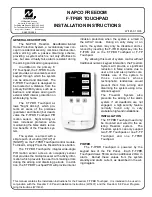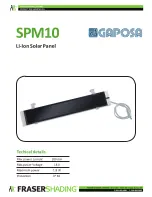
www.znshinesolar.com
Document No.
:
QES/ZX-RD-III032A
- 9 -
5.2
、
ENVIRONMENT CONDITIONS AND SITE SELECTION
ZNSHINE SOLAR module should be installed in the following environmental conditions.
Table 5-1 operation condition
NO
Environmental conditions
Range
1
Recommended Working temperature
-20℃~+47℃
2
Extreme Working temperature
-40℃~+85℃
3
Storage temperature
-20℃~+50℃
4
Humidity
<85RH%
Remarks:
The working environment temperature is the monthly average maximum temperature and
minimum temperature of the installation site. The mechanical load bearing capacity of the solar PV modules
determined based on the installation method. The professional solar PV system installer must be responsible for
calculating the solar PV system machinery when designing the solar PV system load bearing capacity.
If you are planning to use the PV modules where the water damage (Humidity:
>
85RH%) may be possible,
please consult with ZNSHINE SOLAR technical support firstly to determine an appropriate installation method, or
to determine whether the installation is possible.
The modules are certified according to the norm IEC 61215 and others for safe operation in moderate
climates. The operator needs to consider the effect of the high altitude on the operation of the module, when the
modules are installed at high altitude. The maximum altitude allowed for PV Module installation is 2000m.
For most places, PV modules should be installed where the sunlight can be maximally acquired throughout
the year. In the Northern Hemisphere, the PV modules should typically face south, and in the Southern
Hemisphere, the PV modules should typically face north.
When selecting the installation location, avoid areas with trees, buildings, or obstacles because these objects
will form shadows on PV modules, especially when the sun is at the lowest position on the horizon in winter. The
shadow will cause the loss of the output power of the solar photovoltaic system. Although the bypass diode
installed in the PV module can reduce this loss to some extent, do not ignore the shadow factor.
Position the modules to minimize the chances of shading at all times of the day. Try to install modules in a
location where there is rare shading throughout the year.
According to IEC 61701, salt mist corrosion testing of photovoltaic (PV), ZNSHINE SOLAR PV modules can
be installed in corrosive salt areas within proximity of the ocean or sulfurous areas. The module must not be
soaked in the water or in the environment (i.e., fountain, spindrift, etc.) where the module would touch water (pure
water or brine) for a long term. If the modules are placed in an environment of salt fog (i.e., marine environment)
or sulfur (i.e., sulfur sources, volcanoes, etc.), there is a risk of corrosion. It’s not recommended to install the
modules, when the distance is less than 100m ; and it’s recommended to install the modules with the anti-salt
function, when the distance is between 100m and 1km. So stainless steel or aluminum materials must be used to
contact the PV modules, and the installation position must be processed with anti-corrosion treatment.
According to IEC62716 “Ammonia corrosion testing of photovoltaic (PV) modules”, ZNSHINE SOLAR
modules can be safely installed in ammonia-heavy environments, such as farm, meadow and so on.
According to the surrounding environment of the project, use the appropriate protective measures to ensure
the safety of the module installation and reliable. For example, it needs to have around the windproof measures
like design of windbreaks in strong wind area.
The system design needs to have the lightning protection function, it must pay more attention especially in
the installation ground where are more lightning strike.
When installing modules on a roof, the roof must be covered with a layer of fireproof material applicable to













































